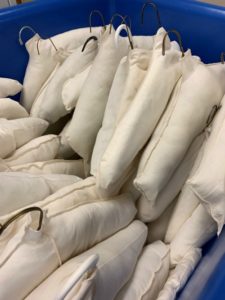The humble hanger. You probably have a closet full of them, right? Well, so does the Avenir Museum, but ours are pretty special.
Custom designed padded hangers support – literally – the individual apparel objects in storage. One of the stealthy enemies of an historic apparel collection is gravity. Just like exposure to light, gravity can be insidiously slow or aggressively rapid, depending on many additional storage variables.
Ideally, historic textiles should be stored flat, and with as few folds as possible. But that is not very practical for the finite storage in your home closet, or indeed for the much larger “closet” securing the Avenir Museum’s 25,000 artifacts, of which some 5,000 objects of apparel are stable enough to hang in storage (instead of stored flat in drawers or boxes).
The hangers
The Avenir’s hangers are even more special because they are tailor-made for the Avenir as community volunteer projects by local sewing guilds, as well as more recently by CSU students employed using a special fund created to help them further their college educations. You can meet our wonderful work-study employees Ashley and Miles in this article. They both started in September 2019, and have made over 900 hangers so far for the benefit of CSU’s historic apparel! But how do you “make” a hanger?!
 One of the ways we help mitigate the effects of gravity on a hanging garment here at the Avenir Museum is to distribute the weight, and a padded hanger far more closely resembles the structure of human shoulders than a thin, two-dimensional hanger. We start with a standard hanger – nothing special in most cases – and then we insert inert batting into an unbleached muslin form that is cut and sewn into a shape that contains the stuffing and covers the hanger in its entirety, except for the hook. Pre-made padded hangers from a museum conservation supplies company would cost about $25 each. Multiply that by the thousands of hanging apparel objects in the Avenir Museum collection, and you see why we are so thankful to have Ashley and Miles cheerfully working away at the serger sewing machines. In turn, the students are involved as undergraduates in this aspect of direct care of museum objects, while at the same time working to support their CSU education. Win-win!
One of the ways we help mitigate the effects of gravity on a hanging garment here at the Avenir Museum is to distribute the weight, and a padded hanger far more closely resembles the structure of human shoulders than a thin, two-dimensional hanger. We start with a standard hanger – nothing special in most cases – and then we insert inert batting into an unbleached muslin form that is cut and sewn into a shape that contains the stuffing and covers the hanger in its entirety, except for the hook. Pre-made padded hangers from a museum conservation supplies company would cost about $25 each. Multiply that by the thousands of hanging apparel objects in the Avenir Museum collection, and you see why we are so thankful to have Ashley and Miles cheerfully working away at the serger sewing machines. In turn, the students are involved as undergraduates in this aspect of direct care of museum objects, while at the same time working to support their CSU education. Win-win!
More care ideas for textiles
Avenir Museum staff are frequently asked about how the everyday person can best care for the textiles they cherish and wish to preserve well into the future. There are some good general guidelines in Caring for your Treasures – Textiles, published by the American Institute for Conservation of Historic and Artistic Works (AIC), so we recommend that as a good place to start. If you decide that your treasure(s) require or would benefit from further professional attention, the AIC website linked above can help you locate a specialist in textile conservation.
The Avenir Museum of Design and Merchandising is in the Department of Design and Merchandising, part of CSU’s College of Health and Human Sciences.
